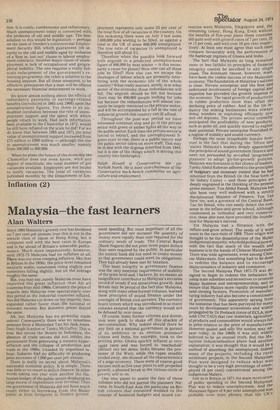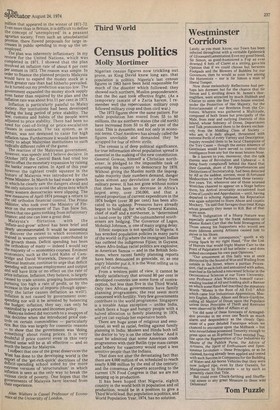Malaysia—the fast learners
Alan Walters
Since 1960 Malaysia's growth rate has bordered on 7 per cent per annum; 'true this is not in the miracle class of Japan or Hong Kong, but it compares well with the best rates in Europe and is far ahead of Britain's miserable performance. Much more impressively, however, until 1972-73 Malaysia had no inflation at all. There was not even creeping inflation, like that in Britain in the 1950s; the price level remained secularly stable, sometimes rising slightly and sometimes falling slightly, but on the average roughly the same. But, you may say, surely Malaysia must have imported the great inflation that hit all countries from mid-I960s. Certainly the price of imports into Malaysia rose spectacularly over this period as the industrial countries inflated. Nor did Malaysia cut down on her imports; they expanded rather faster than the national or domestic income. But domestic prices stayed the same.
Ah, but Malaysia has no powerful trade unions! Consequently there was no relentless pressure from a Malaysian Tan Sri Jack Jones, Data Hugh Scanlon or Tunku McGaffey. This is true. But across the Straits in Indonesia, the absence of trade unions did not inhibit the government from generating a massive hyperinflation and the collapse of production and trade in the 1960s. Unaided by organised labour, Sukarno had no difficulty in producing price increases of 1,000 per cent per annum.
There is really no secret about Malaysia's successful economic policy. It is simple. There was little or no resort to deficit finance. In other words taking one year with another the Malaysian budget of the public sector displayed no large excess of expenditure over revenue. Thus the government of Malaysia did not have much resort either to borrowing from the Malay public or from foreigners to finance govern
ment spending. But most important of all the government did not increase the quantity of money more rapidly than was required for the ordinary needs of trade. The Central Bank (Bank Negara) did not print more paper dollars than were required by the public. In particular the central bank did not need to create money so that government could meet its obligations. They had already been met by taxation.
This basic integrity in government finance was the only essential requirement of stability of the price level and, I believe, by no means an insignificant contributor to Malaysia's enviable record of steady if not miraculous growth. And Britain may be proud of the fact that Malaysia, along with many other former colonies, learned these principles of sound finance under the oversight of British civil servants. The currency board system which was introduced in so many colonies ensured that the currency would not be debased by over-issue.
Of course, many former colonies and dominions were quick to shake off this shackle of neo-colonialism. Why indeed should there be any limit on a national government in pursuit of its ambitions or its election promises? Ghana and India, for example, took to the printing press. Ghana quickly inflated at very rapid rates and was forced to 'reschedule' (default on) her debts. India became the pensioner of the West; while the rupee steadily eroded away, she showed all the characteristics of a seige economy. There were of course good excuses such as five-year plans to self-propelled growth, a planned break in the vicious circle of poverty and so on.
One may pause to assess the fate of those colonies who did not pursue the planners' Nirvana. In South-East Asia the particular ex-British colonies that remained wedded to the concept of balanced budgets and sound cur
rencies were, Malaysia, Singapore and, the remaining colony, Hong Kong. Even without the benefits of five-year plans these countries did quite well with growth rates of? per cent, 10 or 11 per cent, and well over 16 per cent respectively. At least one must agree that such rates compare favourably with the performance of the bankrupt regimes of Ghana and India. The fact that Malaysia so long remained more or less faithful to principles of financial integrity cannot be ascribed to any single cause. The dominant reason, however, must, have been the visible success of the Malaysian economy. The foundation of fvlalaysia's success is clear. Private enterprise and the free and unfettered involvement of foreign capital and expertise has provided the growth impetus of the economy. The rapid growth of productivity in rubber production more than offset the • declining price of rubber. And in the tin industry the mining businesses were always doing wonders in exploiting efficiently new and old deposits. The private sector correctly anticipated the profitability of new products. such as palm oil, and quickly moved to exploit their potential. Private enterprise flourished in a regime of stability and sound currency.
Perhaps the most remarkable feature however is the fact that during the 'fifties and 'sixties Malaysia's leaders deeply appreciated the principles of sound government finance and were not persuaded by so-called 'progressive planners' to adopt 'go-for-growth' policies. Malaysia was fortunate in her choice of leaders. Tunku Abdul Rahman adhered to the principles of budgetary and monetary control that he had inherited from the British (in the final form of Sir Sidney Caine) — and these principles are deeply engrained in the thinking of the present prime minister, Tun Abdul Razak. Malaysia has also been very well endowed with a strictly disciplinarian Minister of Finance, Tun Tan Siew Sin, and a governor of the Central Bank, Tan Sri Itmail, who can easily detect the nonsense in the inflate-and-grow school. Although condemned as 'orthodox' and very conservative, these able men have provided the foundation for Malaysia's success.
Yet Malaysia had a flirtation with the inflate-and-grow school. The seeds of itwere sown in the race riots of 1969. Their origin was thought to be the dissatisfaction of the Malay (indigenous) majority, who hold political power, with the fact that much of the wealth and business is in the hands of Chinese Malaysians. There was wide agreement, even among Chinese Malaysians, that something had to be done to redress the balance and to encourage Malayanisation of industry and commerce.
The Second Malaysia Plan 1971-75 was designed to begin to redress the imbalance by using state subsidies and incentives to promote Malay business and entrepreneurship, and to ensure that Malays more rapidly developed as land owning farmers. Promotion of manufacturing industry had also become a commitment of government. This apparently sprang froM the nonsense that has been purveyed for manY years by development economists and widely propagated by Dr Prebisch (once of ECLA, noW with UNCTAD) that raw materials, agricultural products and commodities would always fall in price relative to the price of manufactures. However quaint and silly the notion may appear today, in the 1960s it was still widelY believed to be an eternal truth. But the Malaysian industrialisation plans had another explanation; it was thought that it would be a method of absorbing the unemployed. Indeed many of the projects, including the rural settlement projects, in the Second Malaysian Plan were designed to reduce what was thought to be a very high percentage of unemployed (8 per cent) concentrated among the indigenous Malays.
Just as in Britain in 1971 the main motivation of public spending in the Second Malaysian Plan was to reduce unemployment. And the Malaysian figure of 8 per cent unemployed was probably even more phoney than the UK's million that appeared in the winter of 1971-72. Even more than in Britain, it is difficult to define the concept of 'unemployed' in a peasant agrarian society. From such an unsubstantial premise, there flowed proposals for large increases in public spending to mop up the unemployed. The plan was inherently inflationary. In my review for the United Nations, which was completed in 1971, I showed that the plan involved an inflation rate of about 6 per cent Per annum in 1973. The reason was simple. In Order to finance the planned projects Malaysia would have to expand the money stock at a much greater rate than had hitherto prevailed. As it turned out my prediction was too low. The government expanded the money stock supply even faster than required by the plan and the inflation rate was about 9 to 11 per cent in 1973.
Inflation is particularly painful to Malay society. Her institutions had been developed during the long period of price stability. The law, customs and habits of the people were adjusted to price stability. There had been no need for cost-of-living or price-escalation clauses in contracts. The tax system, as in Britain, was not designed to cater for high inflation rates. Furthermore it would have been costly to adapt Malaysian institutions to such radically different rules of the game. The reaction of the Malaysian government, however, was speedy and I believe decisive. In October 1972 the Central Bank had tried too late to offset the monetary expansion by raising the banks' reserve ratios. In April of this year however the tightest credit squeeze in the history of Malaysia was introduced by the Prime Minister. In March he had made a speech
In which, he clearly saw the dangers ahead and
the only solution to avoid the abyss into which many western democracies were slipping. The new measures of April 1974 presage a return to the old orthodox financial control. The Prime Minister, who took over the Ministry of Fin ance on the retirement of Tun Tan Slew Sin, knows that one gains nothing from inflationary finance; and one can lose a great deal. Malaysia's flirtation with the
Inflate-and-grow school has been brief and
c-learly unconsummated. It would be interesting to discover the extent to which economists trained in western universities contributed to
the growth thesis. Deficit spending has been the orthodoxy of many — indeed I would say the majority of — economics courses. Eminent economists, such as the Lord Kahn of Cambridge and David Worswick, Director of the National Institute, continue to urge that deficit spending will increase employment and output and will have little or no effect on the rate of Price inflation. Inflation, they believe, is largely caused by trade unions, grasping businessmeni Pursuing too high a rate of profit, or by the increase in the price of imports (though apparently the latter causes deflation as well!). Inflation is not caused by government oversPending nor will it be arrested by balancing the budget; inflation, they say, can only be controlled by a prices and incomes policy. Malaysia indeed did succumb to a soupion of this doctrine when she introduced price controls on certain commodities — particularly nee. But this was largely for cosmetic reasons • — to show that the government was 'doing something' about rising prices. It is very d.oubtful if price control even in this very limited sense will be at all effective — and so much the better for Malaysia. I sufpect that one of the great disservices the West has done to the developing world is the ,exp.ort of the 'get-rich-quick' doctrines of the uericit-spending school aided by the more extreme versions of 'structuralism' in which Inflation is seen as the only way to break the vicious circle of poverty. One hopes that the goVernments of Malaysia have learned from then. experience.
Alan Walters is Cassel Professor of Econowiles at the University of London,



































 Previous page
Previous page